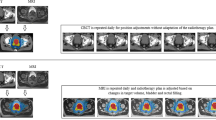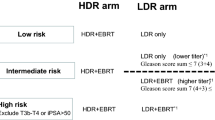Abstract
External-beam radiation therapy (EBRT) combined with brachytherapy is an attractive treatment option for selected patients with clinically localized prostate cancer. This therapeutic strategy offers dosimetric coverage if local-regional microscopic disease is present and provides a highly conformal boost of radiation to the prostate and immediate surrounding tissues. Either low-dose-rate (LDR) permanent brachytherapy or high-dose-rate (HDR) temporary brachytherapy can be combined with EBRT; such combined-modality therapy (CMT) is typically used to treat patients with intermediate-risk to high-risk, clinically localized disease. Controversy persists with regard to indications for CMT, choice of LDR or HDR boost, isotope selection for LDR, and integration of EBRT and brachytherapy. Initial findings from prospective, multicenter trials of CMT support the feasibility of this strategy. Updated results from these trials as well as those of ongoing and new phase III trials should help to define the role of CMT in the management of prostate cancer. In the meantime, long-term expectations for outcomes of CMT are based largely on the experience of single institutions, which demonstrate that CMT with EBRT and either LDR or HDR brachytherapy can provide freedom from disease recurrence with acceptable toxicity.
Key Points
-
Combined-modality therapy (CMT) offers patients with adverse-risk, clinically localized prostate cancer the advantages of both broad regional coverage derived from external-beam radiation therapy (EBRT) and a highly conformal boost with brachytherapy
-
Controversies remain in relation to the use of CMT: appropriate patient selection, choice of low-dose-rate (LDR) versus high-dose-rate (HDR) brachytherapy boost, and how best to integrate EBRT and brachytherapy
-
A growing number of retrospective series indicate that both LDR and HDR boost offer clinical outcomes and toxicity profiles that compare well with other treatment approaches for similar patient populations
-
Phase II and III studies, although generally of shorter median follow-up than retrospective series, support the notion that CMT is feasible
-
Extended follow-up and completion of additional prospective studies are needed in order to define the role of CMT in treatment of prostate cancer
This is a preview of subscription content, access via your institution
Access options
Subscribe to this journal
Receive 12 print issues and online access
$209.00 per year
only $17.42 per issue
Buy this article
- Purchase on Springer Link
- Instant access to full article PDF
Prices may be subject to local taxes which are calculated during checkout

Similar content being viewed by others
References
Barringer B (1917) Radium in the treatment of carcinoma of the bladder and prostate. JAMA 68: 1227–1230
Whitmore W et al. (1972) Retropubic implantation of iodine 125 in the treatment of prostate cancer. J Urol 108: 918–920
Zelefsky M and Whitmore W (1997) Long-term results of retropubic permanent 125iodine implantation of the prostate for clinically localized prostatic cancer. J Urol 158: 23–29
Torp-Pedersen S et al. (1987) Transperineal I-125 seed implantation in prostate cancer guided by transrectal ultrasound. Prog Clin Biol Res 237: 143–152
Blasko JC et al. (1991) Transperineal ultrasound-guided implantation of the prostate: morbidity and complications. Scand J Urol Nephrol 137 (Suppl): 113–118
Scardino P (2005) Update: NCCN prostate cancer Clinical Practice Guidelines. J Natl Compr Canc Netw 3 (Suppl 1): S29–S33
Frank SJ et al. (2007) Interstitial implant alone or in combination with external beam radiation therapy for intermediate-risk prostate cancer: a survey of practice patterns in the United States. Brachytherapy 6: 2–8
Brenner D and Hall E (1999) Fractionation and protraction for radiotherapy of prostate carcinoma. Int J Radiat Oncol Biol Phys 43: 1095–1101
Guerrero M and Li XA (2006) Halftime for repair of sublethal damage in normal bladder and rectum: an analysis of clinical data from cervix brachytherapy. Phys Med Biol 51: 4063–4071
Nag S et al. (1999) American Brachytherapy Society (ABS) recommendations for transperineal permanent brachytherapy of prostate cancer. Int J Radiat Oncol Biol Phys 44: 789–799
Beyer D et al. (2000) American brachytherapy society recommendations for clinical implementation of NIST-1999 standards for (103)palladium brachytherapy. The clinical research committee of the American Brachytherapy Society. Int J Radiat Oncol Biol Phys 47: 273–275
Rivard MJ et al. (2007) American Brachytherapy Society recommends no change for prostate permanent implant dose prescriptions using iodine-125 or palladium-103. Brachytherapy 6: 34–37
Ling C (1992) Permanent implants using Au-198, Pd-103 and I-125: radiobiological considerations based on the linear quadratic model. Int J Radiat Oncol Biol Phys 23: 81–87
Potters L et al. (2003) The effect of isotope selection on the prostate-specific antigen response in patients treated with permanent prostate brachytherapy. Brachytherapy 2: 26–31
Peschel R et al. (2004) Iodine 125 versus palladium 103 implants for prostate cancer: clinical outcomes and complications. Cancer J 10: 170–174
Wallner K et al. (2003) 125I versus 103Pd for low-risk prostate cancer: preliminary PSA outcomes from a prospective randomized multicenter trial. Int J Radiat Oncol Biol Phys 57: 1297–1303
Herstein A et al. (2005) I-125 versus Pd-103 for low-risk prostate cancer: long-term morbidity outcomes from a prospective randomized multicenter controlled trial. Cancer J 11: 385–389
Critz F et al. (2000) Simultaneous irradiation for prostate cancer: intermediate results with modern techniques. J Urol 164: 738–741
Lee W et al. (2006) A Phase II study of external beam radiotherapy combined with permanent source brachytherapy for intermediate-risk, clinically localized adenocarcinoma of the prostate: preliminary results of RTOG P-0019. Int J Radiat Oncol Biol Phys 64: 804–809
Lee W et al. (2007) Late toxicity and biochemical recurrence after external-beam radiotherapy combined with permanent-source prostate brachytherapy. Cancer 109: 1506–1512
Hurwitz et al. (2008) Combination external beam radiation and brachytherapy boost with androgen suppression for treatment of intermediate-risk prostate cancer: an initial report of CALGB 99809. Int J Radiat Oncol Biol Phys [10.1016/j.ijrobp.2008.01.010]
Sylvester J et al. (2007) 15-Year biochemical relapse free survival in clinical stage T1–T3 prostate cancer following combined external beam radiotherapy and brachytherapy; Seattle experience. Int J Radiat Oncol Biol Phys 67: 57–64
Dattoli M et al. (2007) Long-term outcomes after treatment with brachytherapy and supplemental conformal radiation for prostate cancer patients having intermediate and high-risk features. Cancer 110: 551–555
Merrick G et al. (2005) Impact of supplemental external beam radiotherapy and/or androgen deprivation therapy on biochemical outcome after permanent prostate brachytherapy. Int J Radiat Oncol Biol Phys 61: 32–43
Singh A et al. (2004) Combined external beam radiotherapy and Pd-103 brachytherapy boost improves biochemical failure free survival in patients with clinically localized prostate cancer: results of a matched pair analysis. Prostate 62: 54–60
Stock R et al. (2004) Combined modality treatment in the management of high-risk prostate cancer. Int J Radiat Oncol Biol Phys 59: 1352–1359
Hoskin PJ et al. (2007) High dose rate brachytherapy in combination with external beam radiotherapy in the radical treatment of prostate cancer: initial results of a randomised phase three trial. Radiother Oncol 84: 114–120
Vargas C et al. (2006) High-dose irradiation for prostate cancer via a high-dose-rate brachytherapy boost: results of a phase I to II study. Int J Radiat Oncol Biol Phys 66: 416–423
Demanes D et al. (2005) High-dose-rate intensity-modulated brachytherapy with external beam radiotherapy for prostate cancer: California endocurietherapy's 10-year results. Int J Radiat Oncol Biol Phys 61: 1306–1316
Galalae R et al. (2004) Long-term outcome by risk factors using conformal high-dose-rate brachytherapy (HDR-BT) boost with or without neoadjuvant androgen suppression for localized prostate cancer. Int J Radiat Oncol Biol Phys 58: 1048–1055
Deger S et al. (2005) High dose rate (HDR) brachytherapy with conformal radiation therapy for localized prostate cancer. Eur Urol 47: 441–448
Phan TP et al. (2007) High dose rate brachytherapy as a boost for the treatment of localized prostate cancer. J Urol 177: 123–127
Astrom et al. (2005) Long-term outcome of high dose rate brachytherapy in radiotherapy of localised prostate cancer. Radiother Oncol 74: 157–161
Hsu IC et al. (2005) Combined modality treatment with high-dose-rate brachytherapy boost for locally advanced prostate cancer. Brachytherapy 4: 202–206
Yamada Y et al. (2006) Favorable clinical outcomes of three-dimensional computer-optimized high-dose-rate prostate brachytherapy in the mangement of localized prostate cancer. Brachytherapy 5: 157–164
Izard MA et al. (2006) Six year experience of external beam radiotherapy, brachytherapy boost with a 1 Ci 192Ir source, and neoadjuvant hormonal manipulation for prostate cancer. Int J Radiat Oncol Biol Phys 66: 38–47
Nag S et al. (2002) American Brachytherapy Society recommendations for reporting morbidity after prostate brachytherapy. Int J Radiat Oncol Biol Phys 54: 462–470
Ghaly M et al. (2003) The effect of supplemental beam radiation on prostate brachytherapy-related morbidity: morbidity outcomes from two prospective randomized multicenter trials. Int J Radiat Oncol Biol Phys 55: 1288–1293
Albert M et al. (2003) Late genitourinary and gastrointestinal toxicity after magnetic resonance image-guided prostate brachytherapy with or without neoadjuvant external beam radiation therapy. Cancer 98: 949–954
Kang SK et al. (2002) Gastrointestinal toxicity of transperineal interstitial prostate brachytherapy. Int J Radiat Oncol Biol Phys 53: 99–103
Sarosdy MF et al. (2004) Urinary and rectal complications of contemporary permanent transperineal brachytherapy for prostate carcinoma with or without external beam radiation therapy. Cancer 101: 754–760
Moreira SG et al. (2004) Devastating complications after brachytherapy in the treatment of prostate adenocarcinoma. BJU Int 93: 31–35
Tran A et al. (2005) Rectal fistulas after prostate brachytherapy. Int J Radiat Oncol Biol Phys 63: 150–154
Pinkawa M et al. (2006) Health related quality of life after permanent interstitial brachytherapy for prostate cancer: correlation with postimplant CT scan parameters. Strahlenther Onkol 182: 660–665
Kelly K et al. (2006) Prediction of urinary symptoms after 125iodine prostate brachytherapy. Clin Oncol (R Coll Radiol) 18: 326–332
Shah JN and Ennis RD (2006) Rectal toxicity profile after transperineal interstitial permanent prostate brachytherapy: use of a comprehensive toxicity scoring system and identification of rectal dosimetric toxicity predictors. Int J Radiat Oncol Biol Phys 64: 817–824
Taussky D et al. (2004) Factors predicting an increased dose to the penile bulb in permanent seed prostate brachytherapy. Brachytherapy 3: 125–129
Zaider M et al. (2005) Methodology for biologically-based treatment planning for combined low-dose-rate (permanent implant) and high-dose-rate (fractionated) treatment of prostate cancer. Int J Radiat Oncol Biol Phys 61: 702–713
Soumarova R et al. (2006) Acute toxicity of conformal high dose interstitial brachytherapy boost in prostate cancer. Neoplasia 53: 410–417
Duchesne GM et al. (2007) Patterns of toxicity following high-dose rate brachytherapy boost for prostate cancer: mature prospective phase I/II study results. Radiother Oncol 84: 128–134
Pinkawa M et al. (2006) Dose-volume impact in high-dose-rate iridium-192 brachytherapy as a boost to external beam radiotherapy for localized prostate cancer—a phase II study. Radiother Oncol 78: 41–46
Wahlgren T et al. (2007) Promising long-term health-related quality of life after high-dose-rate brachytherapy boost for localized prostate cancer. Int J Radiat Oncol Biol Phys 69: 662–670
Vordermark D et al. (2006) 3-D conformal treatment of prostate cancer to 74 Gy vs. high-dose-rate brachytherapy boost: a cross-sectional quality-of-life survey. Acta Oncol 45: 708–716
Jo Y et al. (2005) Radical prostatectomy versus high-dose rate brachytherapy for prostate cancer: effects on health-related quality of life. BJU Int 96: 43–47
Author information
Authors and Affiliations
Ethics declarations
Competing interests
The author declares no competing financial interests.
Rights and permissions
About this article
Cite this article
Hurwitz, M. Technology Insight: combined external-beam radiation therapy and brachytherapy in the management of prostate cancer. Nat Rev Clin Oncol 5, 668–676 (2008). https://doi.org/10.1038/ncponc1224
Received:
Accepted:
Published:
Issue Date:
DOI: https://doi.org/10.1038/ncponc1224
This article is cited by
-
The evolution of brachytherapy for prostate cancer
Nature Reviews Urology (2017)



